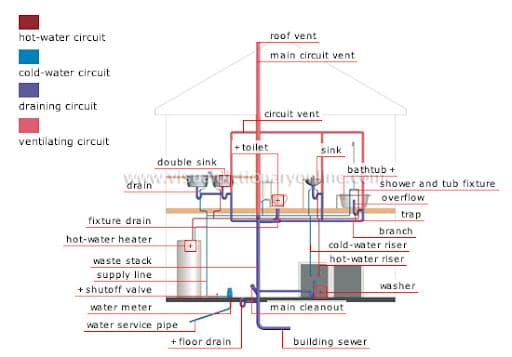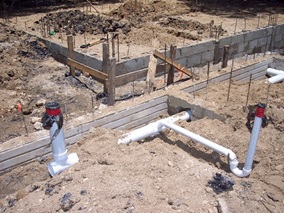Are you currently trying to find related information around The Inner Workings of Your Home's Plumbing?

Comprehending just how your home's plumbing system works is necessary for every single house owner. From providing tidy water for alcohol consumption, food preparation, and showering to securely getting rid of wastewater, a properly maintained pipes system is crucial for your family members's health and comfort. In this extensive guide, we'll check out the detailed network that composes your home's pipes and deal ideas on maintenance, upgrades, and managing typical problems.
Intro
Your home's pipes system is greater than just a network of pipes; it's a complicated system that ensures you have accessibility to tidy water and efficient wastewater removal. Recognizing its parts and exactly how they collaborate can assist you stop expensive repair services and guarantee everything runs smoothly.
Basic Components of a Pipes System
Pipelines and Tubing
At the heart of your pipes system are the pipes and tubes that bring water throughout your home. These can be constructed from various materials such as copper, PVC, or PEX, each with its advantages in terms of longevity and cost-effectiveness.
Fixtures: Sinks, Toilets, Showers, etc.
Fixtures like sinks, bathrooms, showers, and tubs are where water is utilized in your home. Understanding just how these components link to the plumbing system helps in detecting troubles and preparing upgrades.
Valves and Shut-off Factors
Valves control the circulation of water in your pipes system. Shut-off valves are crucial throughout emergency situations or when you need to make repairs, permitting you to separate parts of the system without interrupting water flow to the whole home.
Supply Of Water System
Key Water Line
The primary water line links your home to the municipal water or a personal well. It's where water enters your home and is distributed to numerous fixtures.
Water Meter and Stress Regulator
The water meter actions your water use, while a pressure regulatory authority makes sure that water flows at a secure pressure throughout your home's plumbing system, stopping damage to pipelines and fixtures.
Cold Water vs. Hot Water Lines
Recognizing the distinction in between cold water lines, which supply water directly from the major, and hot water lines, which lug heated water from the hot water heater, assists in troubleshooting and planning for upgrades.
Water drainage System
Drain Pipes Pipeline and Traps
Drain pipes lug wastewater away from sinks, showers, and toilets to the sewage system or sewage-disposal tank. Catches stop sewage system gases from entering your home and likewise trap particles that might cause obstructions.
Air flow Pipes
Air flow pipelines allow air right into the water drainage system, preventing suction that can slow down drainage and cause catches to vacant. Correct ventilation is essential for keeping the stability of your pipes system.
Value of Proper Water Drainage
Guaranteeing correct drain protects against back-ups and water damage. Consistently cleaning drains pipes and preserving catches can avoid pricey repair work and prolong the life of your plumbing system.
Water Heater
Sorts Of Water Heaters
Hot water heater can be tankless or conventional tank-style. Tankless heating systems heat water as needed, while tanks keep warmed water for immediate usage.
Updating Your Pipes System
Reasons for Updating
Upgrading to water-efficient components or changing old pipes can boost water quality, minimize water bills, and boost the worth of your home.
Modern Plumbing Technologies and Their Advantages
Explore innovations like wise leakage detectors, water-saving toilets, and energy-efficient hot water heater that can conserve money and minimize environmental effect.
Price Considerations and ROI
Calculate the in advance prices versus long-term cost savings when taking into consideration plumbing upgrades. Numerous upgrades spend for themselves via reduced utility bills and fewer repair services.
How Water Heaters Connect to the Pipes System
Recognizing how water heaters link to both the cold water supply and warm water circulation lines helps in identifying problems like inadequate warm water or leaks.
Maintenance Tips for Water Heaters
Consistently flushing your water heater to eliminate debris, examining the temperature level settings, and examining for leakages can expand its life-span and boost energy efficiency.
Typical Plumbing Concerns
Leakages and Their Causes
Leaks can occur because of aging pipelines, loosened installations, or high water stress. Addressing leakages promptly prevents water damage and mold growth.
Blockages and Obstructions
Blockages in drains pipes and toilets are usually caused by flushing non-flushable items or an accumulation of grease and hair. Using drainpipe displays and being mindful of what decreases your drains pipes can protect against obstructions.
Indicators of Pipes Troubles to Look For
Low water pressure, sluggish drains, foul odors, or uncommonly high water costs are indicators of possible pipes troubles that need to be attended to without delay.
Plumbing Upkeep Tips
Normal Inspections and Checks
Set up yearly pipes assessments to catch concerns early. Try to find indicators of leakages, rust, or mineral accumulation in taps and showerheads.
Do It Yourself Maintenance Tasks
Easy tasks like cleaning tap aerators, looking for bathroom leakages making use of color tablets, or shielding subjected pipes in chilly climates can stop major pipes concerns.
When to Call an Expert Plumber
Know when a pipes concern calls for professional knowledge. Attempting intricate repairs without correct understanding can lead to more damages and higher repair expenses.
Tips for Minimizing Water Usage
Straightforward routines like repairing leakages quickly, taking shorter showers, and running full loads of washing and dishes can preserve water and reduced your utility bills.
Eco-Friendly Pipes Options
Think about sustainable pipes materials like bamboo for flooring, which is durable and green, or recycled glass for countertops.
Emergency Readiness
Steps to Take Throughout a Plumbing Emergency situation
Know where your shut-off shutoffs are located and just how to switch off the supply of water in case of a ruptured pipe or major leakage.
Importance of Having Emergency Situation Contacts Helpful
Maintain contact information for regional plumbing technicians or emergency services readily offered for quick action throughout a plumbing situation.
Environmental Influence and Conservation
Water-Saving Fixtures and Home Appliances
Mounting low-flow faucets, showerheads, and commodes can dramatically minimize water use without giving up performance.
DIY Emergency Situation Fixes (When Appropriate).
Temporary solutions like using duct tape to patch a dripping pipe or positioning a container under a trickling tap can minimize damage up until an expert plumber arrives.
Conclusion.
Comprehending the anatomy of your home's pipes system empowers you to maintain it efficiently, saving money and time on repair services. By following regular maintenance regimens and remaining notified about contemporary pipes modern technologies, you can guarantee your plumbing system operates effectively for several years ahead.
HOW YOUR PLUMBING SYSTEM WORKS
Which Pipes Do What?
- Blue lines = fresh water supply entering the building
- Red lines = hot water supply entering the building
- Grey lines = pipes carrying waste away from the building and venting pipes carrying gases away from the building (through the roof)
YOUR MAIN PLUMBING SYSTEMS
There are two main plumbing systems that support your home s basic plumbing needs one that brings clean water into your home, and one that sends dirty water away from your home. Connected to the toilet, bath, shower, and other faucets in your home, these two systems keep your water flowing in the right directions.
ACCESSING FRESH WATER
Fresh and clean water is brought into your home through the main water supply line . Filtered through one pipe, this water is pressured to flow into the various fixtures in your home at any given time.
This water can be sourced from a well located on your property, a pond or river (mostly cottages), or, as in most cases, from the city s municipal water treatment centre. However, it is important to note that water that is untreated, such as the water siphoned from ponds or rivers, may not be safe to drink. Personal water supplies always need to be treated for hardness and contaminants before consumed.
MUNICIPAL WATER SUPPLIES
- Improve taste and odour
- Remove sediment
- Eliminate hardness
- Reduce chlorine
COLD WATER SUPPLY VS. HOT WATER SUPPLY
Cold water flows into your home or building through the service line, which then distributes hot or cold water to your fixtures. This line is most commonly run through a central column that runs floor to floor. Hot water runs in short and straight pipes as the longer the pipeline, the more heat that will be lost in the transfer. Having shorter pipes also allows residents to access hot water more quickly.
WASTE WATER SYSTEM
Your wastewater system is divided into two parts pipes that send wastewater away from your home and venting pipes that send sewer gas away from your home. Sewage water travels through pipes that flush the water and waste towards local sewers that are operated and managed by your city or town. Most sewer systems rely on gravity to move the wastewater to where it needs to go.
The further away from your toilet or sink, the larger wastewater pipes become. This allows for waste to be disposed of from various parts of your home or business at once without pipe blockages. The angle and flow of these pipes are also essential for keeping your waste pipes clear of build up.
https://harrisplumbing.ca/how-your-home-plumbing-system-works/

I'm just very focused on Anatomy of a House: Understanding the Components and I am hoping you enjoyed reading my piece. Are you aware of someone else who is occupied with the subject? Take a moment to promote it. I enjoy reading our article about Anatomy of a House: Understanding the Components.
Call Today
Comments on “What You Need to Know About Your Home's Plumbing System Anatomy”